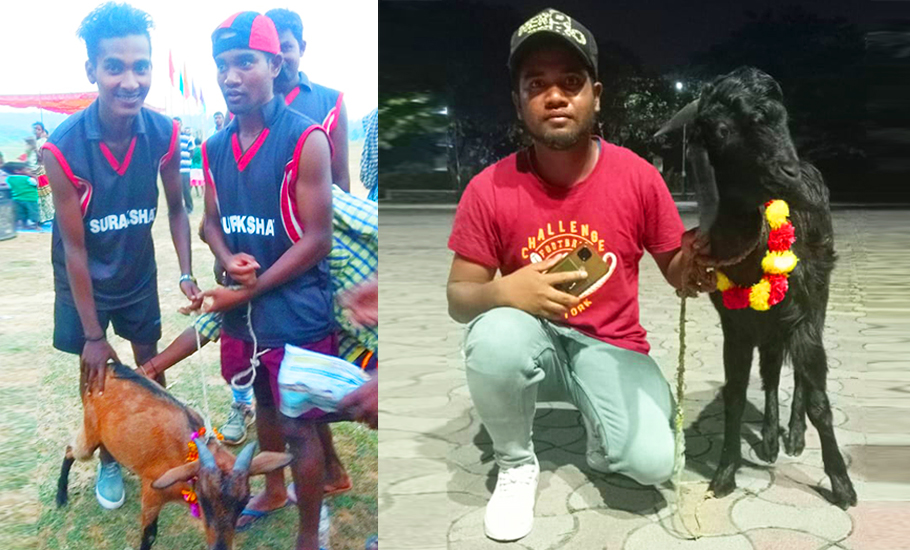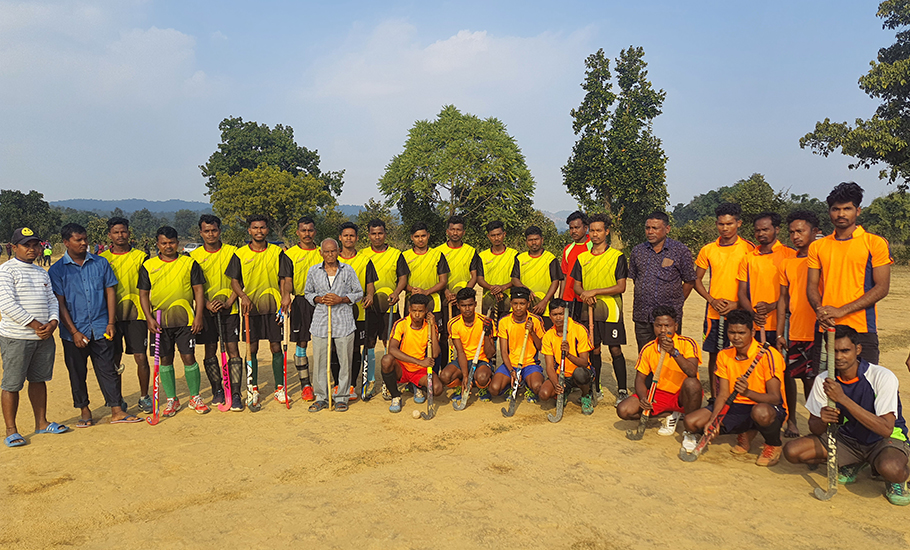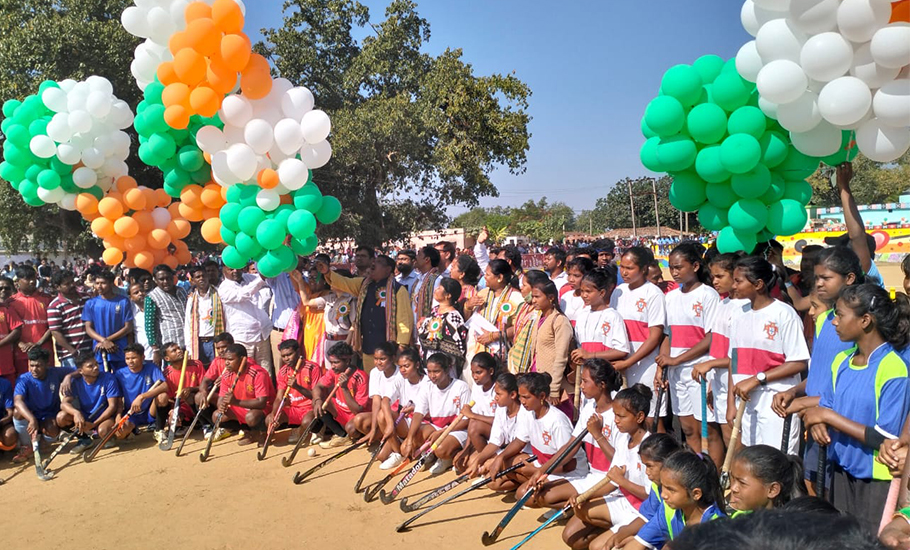
- Home
- News
- Analysis
- States
- Perspective
- Videos
- Education
- Entertainment
- Elections
- World Cup 2023
- Features
- Health
- Business
- Series
- Economy Series
- Earth Day
- Kashmir’s Frozen Turbulence
- India@75
- The legend of Ramjanmabhoomi
- Liberalisation@30
- How to tame a dragon
- Celebrating biodiversity
- Farm Matters
- 50 days of solitude
- Bringing Migrants Home
- Budget 2020
- Jharkhand Votes
- The Federal Investigates
- The Federal Impact
- Vanishing Sand
- Gandhi @ 150
- Andhra Today
- Field report
- Operation Gulmarg
- Pandemic @1 Mn in India
- The Federal Year-End
- The Zero Year
- Premium
- Science
- Brand studio
- Home
- NewsNews
- Analysis
- StatesStates
- PerspectivePerspective
- VideosVideos
- Entertainment
- ElectionsElections
- Sports
- Loading...
Sports - Features
- BusinessBusiness
- Premium
- Loading...
Premium

From Kukuda to Khasi Cup, how a flavour of fun entered hockey in Odisha’s tribal district

It’s a late winter morning. Having hurriedly finished an early lunch at around 11.30 am, 83-year-old Salmon Minz rushes out of his house in Nimdihi village, under Balisankara block of Odisha’s tribal Sundargarh district. Minz takes quick steps on the uneven muddy path that leads to the dusty village ground surrounded by bushes and trees — the venue for the annual and much anticipated...
It’s a late winter morning. Having hurriedly finished an early lunch at around 11.30 am, 83-year-old Salmon Minz rushes out of his house in Nimdihi village, under Balisankara block of Odisha’s tribal Sundargarh district. Minz takes quick steps on the uneven muddy path that leads to the dusty village ground surrounded by bushes and trees — the venue for the annual and much anticipated Khasi (goat) Cup.
Cut to the ground, which for Minz is still about a kilometre away, and a crowd of about 200 people, including men, women and children has settled, chattering loudly. Many others, with their kids in tow, some carrying toddlers on their shoulders, are trickling in. In one corner of the ground, a few makeshift shops selling snacks and other eatables are doing brisk business.
As the players enter the field, the chattering stops, giving way to loud cheers and applause. The young ones try to encourage the players with whistles. There is euphoria all around. A sense of enthusiasm rings in the air.
In the villages of Sundargarh, hockey is part religion, part obsession. Despite cricket’s countrywide popularity, in Sundargarh, it’s just another sport. The resource-rich region has produced five national captains of the Indian hockey team and over 80 international players.
And that is why rural tournaments are more than just a fun activity both for the players and the spectators. Every village has a team of its own. It is here that the youngsters learn how to tackle pressure and override it to excel. It is here they build stamina and refine skills that come in handy if they make it to the state or national level teams. And, of course, it is here they get the opportunity to win a goat feast for their village. And so the Khasi Cup is taken very seriously.
When the entire village is a team
Part of the seriousness for the tournament comes from the prize at stake, which is also what gives the tournament its unique name — the khasi, which in Odia means goat.
While a few from the village play, the entire village is the team. The goat that is won by the team is used for a celebratory gala feast for the entire village. The one thing that matters more than the prize itself is the pride of the team, which is the village. It is this aspect which adds to the excitement of watching players of the two teams run around the ground with long curved sticks chasing a small ball that they want to send straight to the opposition’s goal post.

As Odisha gears up to host the International Hockey World Cup from January 13-29, the charm, significance and antiquity of the local tournaments is not lost on anyone.
“Such tournaments have held tightly the interest and passion for hockey in the villagers. I really enjoyed playing such games, all players including those who have played at the national and international levels have grown up playing rural tournaments,” ex-Olympian, Lazarus Barla, who hails from Tilaikani village of the district, tells The Federal.
“The crowd watching the matches are well-versed with the game and its nuances, they understand every bit of it. Your performance makes you a local celebrity, instantly,” adds Barla with a smile.
Father Sanjeet of Raj Club, Nimdihi, says that this year his village is organising the 26th edition of the Khasi Cup. Forty teams are participating in the event and each of the top four teams is going to receive a khasi along with a cup. The position of the winner determines the size of the khasi and the cup they receive.
Other villages have a longer history of holding such annual events.
But no one really knows when the Khasi Cup, or hockey for that matter, took off in the district.
The days that were
Though there is no recorded history of the Khasi Cup, the elderly such as octogenarian Minz say that even their parents had participated in such events. “During those days commutation wasn’t easy. The entire area was a dense forest. On the day of the event, my teammates and I would set off to play in the tournament at 4 am with hockey sticks made of bamboo or the trunk of any tree that would be available and essentials such as food and gamuccha (towel). We covered the entire distance to the venue, which sometimes was would be as far as 20 km, on foot. Since the matches continued till evening, at times the organisers arranged for our dinner and stay,” Minz reminisces.
“Cycle was a luxury for us. But post-1980, a number of teams arrived on cycles,” Minz says. “In our region, hockey is the only means of entertainment and for us the local tournaments are like festivals, it’s a time for indulgence,” he adds.
Apart from the thrill of playing and winning, what adds to the lure of game for the players is the reception they get back in the village. When winners return to the village with the khasi, they are carried in a procession with both men and women garlanding them. In earlier days, what followed was traditional dancing and folk singing that continued till late in the night. The dancing and singing is still a practice in many villages.
For over a decade, Odisha’s first government hockey coach Sylvester Toppo represented his village Lulkidihi in the tournament. Lulkidihi, bordering Chhattisgarh, has produced three international players — the Tirkey brothers, Prabodh and Ignace, and Deep Grace Ekka, who is a member of the Indian women’s team.
Toppo, who has groomed scores of talented players, of which at least 20, including Lazarus Barla, Namita Toppo, Lilima Minz, went on to represent India, has carefully preserved his childhood hockey stick made of bamboo.
With no money to buy balls, children in Odisha’s rural belt would use a local fruit similar to custard apple, covering it with polythene.
“Balls were also made by heating and giving shape to a mix of plastic and charcoal dust in those days,” informs Sylvester Toppo.
From Kukuda to Khasi Cup
While there is a lack of documentation over how hockey came to be a part of Sundargarh, some account suggest, it was introduced in the 1860s by the European missionaries who came to the tribal region. The missionaries are believed to have organised hockey matches as part of extracurricular activities.
Over centuries the sport became a cultural identity for tribes such as Orams, the Kharia, the Munda and the Bhuniya. There are speculations that the natural soil and rock in the limestone belt of Chota Nagpur Plateau, which is rich in calcium, strengthens the bones of the people in the region providing them the energy and stamina needed to be an ace hockey player.
While hockey came to Odisha centuries ago, the Khasi Cup has evolved in its current form over the years.
Abhay Patnaik, an ex-district sports officer of Sundargarh says that around 50 years ago, villages held Kukuda (local chicken) Cup. Later, pigs replaced chicken as the prize before making way for coconuts. “Coconuts were hard to get here. They were brought in from coastal Odisha and it cost a lot. So, the organizers opted for coconut as the prize for winners,” he recounts.
However, neither the Pig, nor the Coconut Cup, lasted long. In the 1980s, Khasi Cup gained popularity and has stayed so since, even though cash has replaced the khasi in some instances because of the rising cost of goats.
“Some villages have begun awarding cash prize along with a cup to the winners,” informs Jay Menduli, a Sundargarh-based journalist.
Also in some villages, eggs and chocolates serve as the prize in the under-14 tournaments.
It isn’t just the prize which has undergone change over time. There has been a visible change in the players too. With better road connectivity, players arrive on bikes with backpacks containing their essentials. Attired in shorts and coloured jerseys, bearing names and numbers on the back, they play with modern hockey equipment.
What has remained unchanged is the love, fun, excitement and emotion associated with the sport and these tournaments.
In order to pick the best side, players are selected entirely on merit-skill and ability. Age or even physical disability has little meaning. At times, even 50-year-olds run around the ground alongside their younger teammates.
“I participated in the tournament till I was about 55,” says Minz, adding, “Though I could move swiftly, my eyesight posed the hindrance, so I stopped participating.”
Gender bender
Not only the old but even women find a place in the male-dominated teams.
Former India women’s captain Subhadra Pradhan says she was picked by her village Saunamara team and played in two such tournaments. “The spirit and intensity of the competition is too high, every player dreams to be part of these tournaments,” Subhadra, who works with the South Eastern Railway, says.
Twenty-year-old Neha Lakra, also from Saunamara, which is home to international stars such as Pradhan, Olympian and vice-captain of India, Amit Rohidas, Hockey India president Dilip Tirkey and Dipsan Tirkey, hopes to get a chance to attend the India camp. Neha, who too has represented her village team, finds the local tournaments, ‘extremely interesting’.
“I can’t express the fun of such games in words,” says Neha.

Organised during holidays, the Khasi Cups draw huge crowds. Local players officiate as umpires but all international rules are adhered to. The duration of the game depends on the number of participating teams. If the number is less, matches are played for one hour.
When there are more teams, the match time is reduced to half an hour or 25 minutes.
According to Minz and Toppo, during their playing days 12 to16 teams participated in a tournament. The number has increased and there are instances when as many as 60 villages join for the fun.
Each team has to pay a nominal entry fee. A soon-to-retire senior coach at Sundargarh’s sports hostel recalls that he played in tournaments where they had to deposit a fee — a princely amount of one paise. That’s, of course, five decades ago. The fee has climbed to a few hundred rupees now.
In order to make the event a grand success, the locals also pitch in and contribute as per their ability. “The entire villagers come out and support the children,” says Subhadra.
What motivates them to contribute is the determination to keep the tradition, culture of local hockey tournaments alive.

